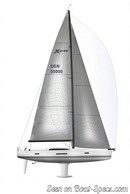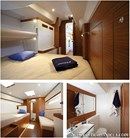Xp 55 Standard
Sailboat specifications
The Xp 55 is a 55’ (16.76m) racer-cruiser sailboat designed by X-Yachts Design Group (Denmark). She is built since 2013 by X-Yachts (Denmark). She has been awarded "2019 - SAIL magazine - Best Large Monohull 51ft and Above".
The Xp 55 is as well listed, on Boat-Specs.com, in Deep draft version (see all the versions compared).
The Xp 55 is as well listed, on Boat-Specs.com, in Deep draft version (see all the versions compared).
Xp 55's main features
- Model
- Xp 55
- Version
- Standard
- Hull type
- Monohull
- Category
- Offshore racer-cruiser sailboat
- Sailboat builder
- Sailboat designer
- Sailboat range
- Country
- Denmark
- Construction
- Fiberglass reinforced epoxy:
Sandwich Core-Cell fiberglass epoxy - First built hull
- 2013
- Last built hull
- Still in production
- Award(s)
- 2019: SAIL magazine - Best Large Monohull 51ft and Above
- Appendages
- Keel : T-shaped keel (with bulb)
- Helm
- Twin helm wheels
- Rudder
- Single spade rudder
- Unsinkable
- No
- Trailerable
- No
- Standard public price ex. VAT (indicative only)
- About775 000 €(2020)
Xp 55's main dimensions
- Hull length
- 55’16.76 m
- Waterline length
- 48’ 10”14.87 m
- Beam (width)
- 15’ 7”4.77 m
- Draft
- 9’ 5”2.85 m
- Light displacement (MLC)
- 37038 lb16800 kg
- Ballast weight
- 13889 lb6300 kg
- Ballast type
- Cast iron fin with lead bulb
Xp 55's rig and sails
- Upwind sail area
- 1877 ft²174.4 m²
- Downwind sail area
- 3655 ft²339.6 m²
- Mainsail area
- 1072 ft²99.6 m²
- Genoa area
- 805 ft²74.8 m²
- Asymmetric spinnaker area
- 2583 ft²240 m²
- Rigging type
- Sloop Marconi 9/10
- Mast configuration
- Keel stepped mast
- Rotating spars
- No
- Number of levels of spreaders
- 3
- Spreaders angle
- Swept-back
- Spars construction
- Aluminum spars (carbon boom as an option)
- Standing rigging
- Single-strand (ROD)
Xp 55's performances
- Upwind sail area to displacementiThe ratio sail area to displacement is obtained by dividing the sail area by the boat's displaced volume to the power two-thirds.
The ratio sail area to displacement can be used to compare the relative sail plan of different sailboats no matter what their size.
Upwind: under 18 the ratio indicates a cruise oriented sailboat with limited performances especially in light wind, while over 25 it indicates a fast sailboat. - 286 ft²/T26.59 m²/T
- Downwind sail area to displacementiThe ratio sail area to displacement is obtained by dividing the sail area by the boat's displaced volume to the power two-thirds.
The ratio sail area to displacement can be used to compare the relative sail plan of different sailboats no matter what their size. - 557 ft²/T51.77 m²/T
- Displacement-length ratio (DLR)iThe Displacement Length Ratio (DLR) is a figure that points out the boat's weight compared to its waterline length. The DLR is obtained by dividing the boat's displacement in tons by the cube of one one-hundredth of the waterline length (in feet).
The DLR can be used to compare the relative mass of different sailboats no matter what their length:
a DLR less than 180 is indicative of a really light sailboat (race boat made for planning), while a DLR greater than 300 is indicative of a heavy cruising sailboat. - 145
- Ballast ratioiThe Ballast ratio is an indicator of stability; it is obtained by dividing the boat's displacement by the mass of the ballast. Since the stability depends also of the hull shapes and the position of the center of gravity, only the boats with similar ballast arrangements and hull shapes should be compared.
The higher the ballast ratio is, the greater is the stability. - 38 %
- Critical hull speediAs a ship moves in the water, it creates standing waves that oppose its movement. This effect increases dramatically the resistance when the boat reaches a speed-length ratio (speed-length ratio is the ratio between the speed in knots and the square root of the waterline length in feet) of about 1.2 (corresponding to a Froude Number of 0.35) . This very sharp rise in resistance, between speed-length ratio of 1.2 to 1.5, is insurmountable for heavy sailboats and so becomes an apparent barrier. This leads to the concept of "hull speed".
The hull speed is obtained by multiplying the square root of the waterline length (in feet) by 1.34. - 9.36 knots
Xp 55's auxiliary engine
- Engine(s)
- 1 inboard engine
- Engine(s) power
- 110 HP
- Fuel type
- Diesel
- Fuel tank capacity
- 105.7 gal400 liters
Xp 55's accommodations and layout
- Cockpit
- Open aft cockpit
- Cabin(s)
- 4
- Berth(s) (min./max.)
- 7 / 9
- Head(s) (min./max.)
- 2 / 3
- Freshwater tank capacity
- 145.3 gal550 liters










X-Yachts Xp 55 interior and accommodations - - 9/13
Picture extracted from the commercial documentation © X-Yachts
Picture extracted from the commercial documentation © X-Yachts


X-Yachts Xp 55 interior and accommodations - - 10/13
Picture extracted from the commercial documentation © X-Yachts
Picture extracted from the commercial documentation © X-Yachts


X-Yachts Xp 55 interior and accommodations - - 11/13
Picture extracted from the commercial documentation © X-Yachts
Picture extracted from the commercial documentation © X-Yachts


X-Yachts Xp 55 interior and accommodations - - 12/13
Picture extracted from the commercial documentation © X-Yachts
Picture extracted from the commercial documentation © X-Yachts


X-Yachts Xp 55 interior and accommodations - - 13/13
Picture extracted from the commercial documentation © X-Yachts
Picture extracted from the commercial documentation © X-Yachts
Similar sailboats that may interest you:
Sailboats
First built hull
Hull length
2011
43’ 7”13.29 m
2008
46’ 2”14.08 m
1988
52’ 6”16 m
2007
53’ 7”16.35 m
2012
54’ 10”16.7 m
2013
55’16.76 m
2004
50’15.24 m
2005
55’16.76 m
1995
60’18.29 m
2012
49’ 2”14.99 m
2016
63’19.19 m
2009
61’ 11”18.86 m
2017
50’ 11”15.51 m
2018
55’ 1”16.8 m
2019
52’ 5”15.98 m